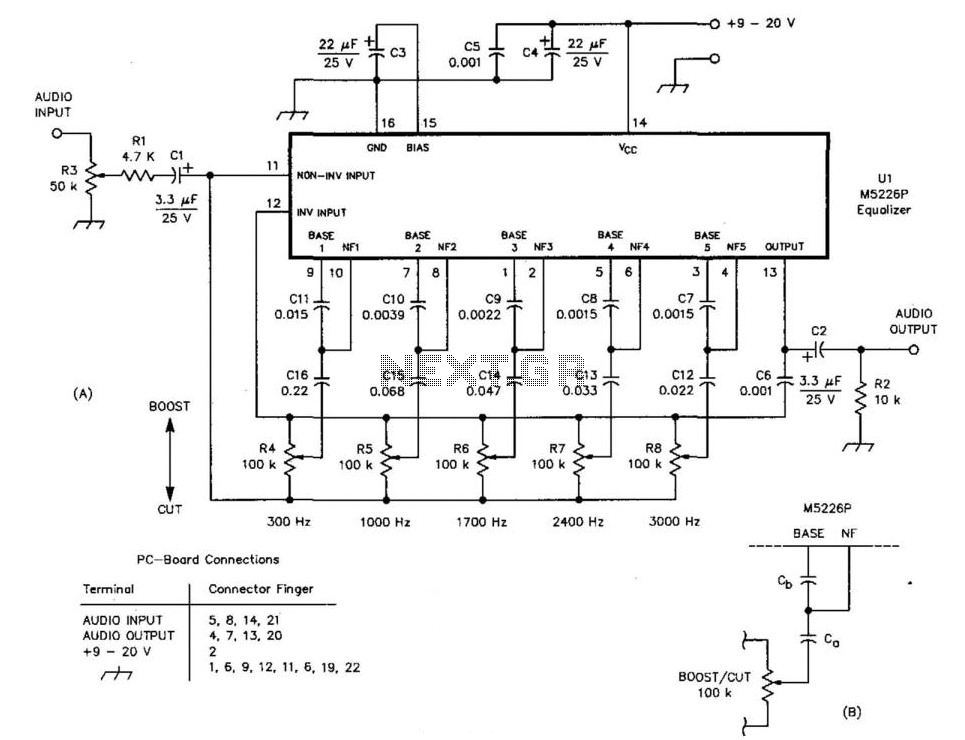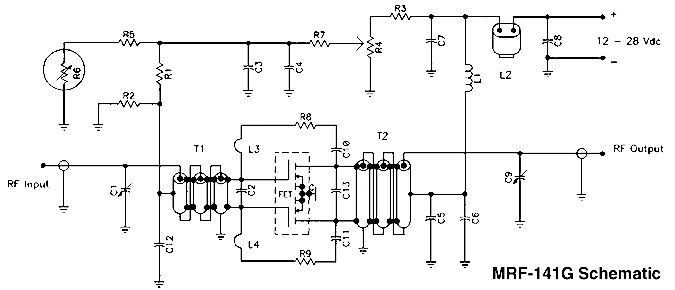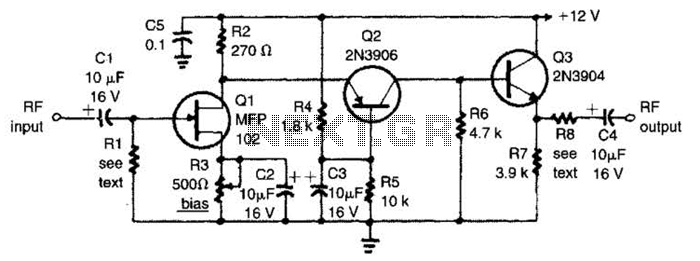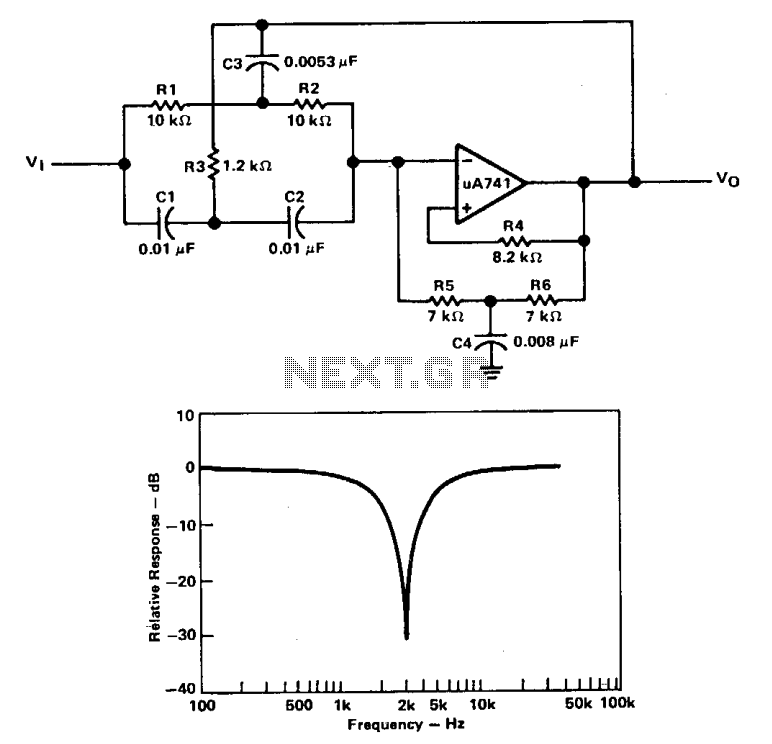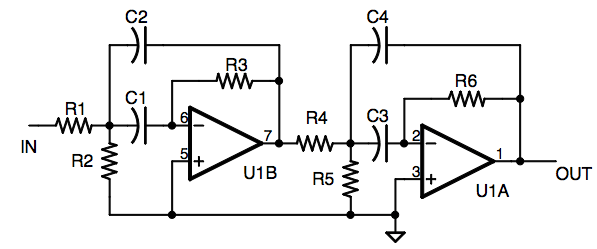
3 Band Graphic Equalizer
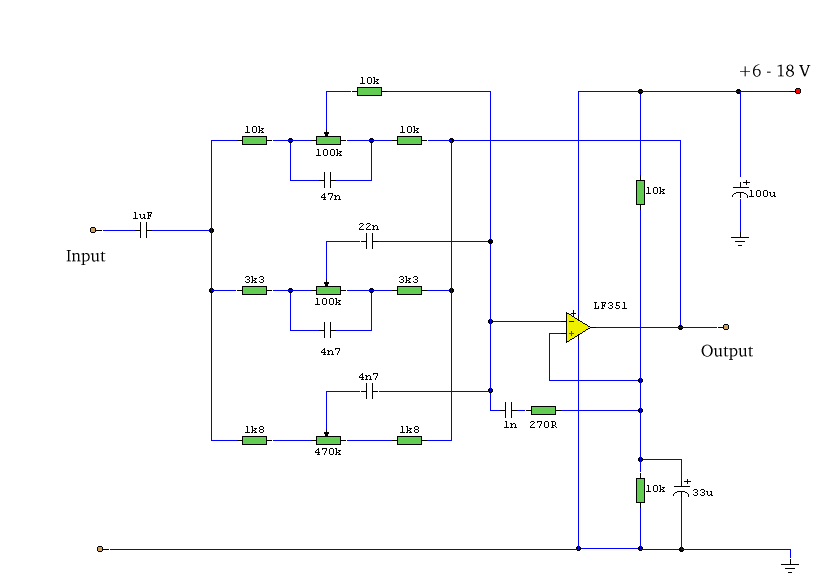
This simple equalizer circuit utilizes a single operational amplifier (op-amp) to provide three distinct frequency ranges: low frequency, mid frequency, and high frequency. With the specified component values, the circuit is capable of delivering an approximate gain of +/-20dB at the designated frequencies of 50Hz, 1kHz, and 10kHz. The supply voltage for this circuit can range from 6 to 30 Volts, with the maximum gain of 20dB achievable only at a supply voltage of 18 Volts.
The equalizer circuit is designed around a single op-amp, which serves as the core amplification element. The configuration allows for adjustment of gain across three frequency bands: low (50Hz), mid (1kHz), and high (10kHz). Each band is typically controlled by a potentiometer or a fixed resistor-capacitor (RC) network that sets the frequency response of the op-amp.
The op-amp is powered by a dual power supply, with the positive and negative voltage rails allowing for symmetrical output swings. The choice of supply voltage directly influences the performance of the circuit; lower voltages may limit the maximum achievable gain, while higher voltages provide greater headroom for signal amplification. It is important to ensure that the op-amp selected can operate effectively within the chosen voltage range, particularly at the upper limit of 30 Volts.
To achieve the specified +/-20dB gain, careful selection of feedback resistors and input capacitors is essential. The feedback network determines the frequency response characteristics, allowing the user to tailor the equalization to specific audio requirements. The circuit can be implemented on a breadboard for prototyping or designed into a more permanent PCB layout for production.
In summary, this op-amp-based equalizer is a versatile solution for audio applications, providing significant control over frequency response with a simple design. Proper component selection and circuit configuration are critical to achieving the desired performance across the specified frequency ranges.Using a single op-amp this easy to make equalizer offers three ranges, low frequency, mid frequency, and high. With component values shown there is approximately +/-20dB of boost or cut at frequencies of 50Hz, 1kHz and 10kHz.
Supply voltage may be anything from 6 to 30 Volts. Maximum boost 20dB is only realized with maximum supply voltage of 18 Volt . 🔗 External reference
The equalizer circuit is designed around a single op-amp, which serves as the core amplification element. The configuration allows for adjustment of gain across three frequency bands: low (50Hz), mid (1kHz), and high (10kHz). Each band is typically controlled by a potentiometer or a fixed resistor-capacitor (RC) network that sets the frequency response of the op-amp.
The op-amp is powered by a dual power supply, with the positive and negative voltage rails allowing for symmetrical output swings. The choice of supply voltage directly influences the performance of the circuit; lower voltages may limit the maximum achievable gain, while higher voltages provide greater headroom for signal amplification. It is important to ensure that the op-amp selected can operate effectively within the chosen voltage range, particularly at the upper limit of 30 Volts.
To achieve the specified +/-20dB gain, careful selection of feedback resistors and input capacitors is essential. The feedback network determines the frequency response characteristics, allowing the user to tailor the equalization to specific audio requirements. The circuit can be implemented on a breadboard for prototyping or designed into a more permanent PCB layout for production.
In summary, this op-amp-based equalizer is a versatile solution for audio applications, providing significant control over frequency response with a simple design. Proper component selection and circuit configuration are critical to achieving the desired performance across the specified frequency ranges.Using a single op-amp this easy to make equalizer offers three ranges, low frequency, mid frequency, and high. With component values shown there is approximately +/-20dB of boost or cut at frequencies of 50Hz, 1kHz and 10kHz.
Supply voltage may be anything from 6 to 30 Volts. Maximum boost 20dB is only realized with maximum supply voltage of 18 Volt . 🔗 External reference
